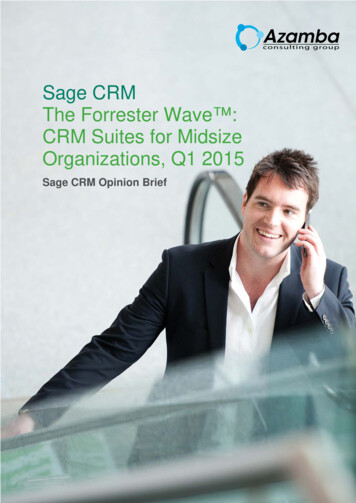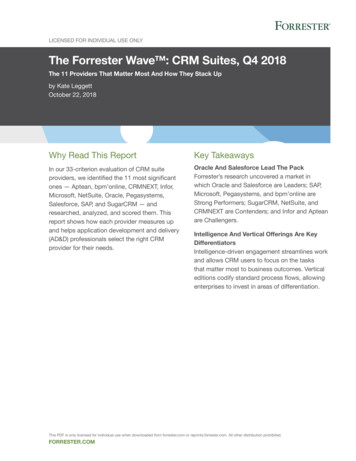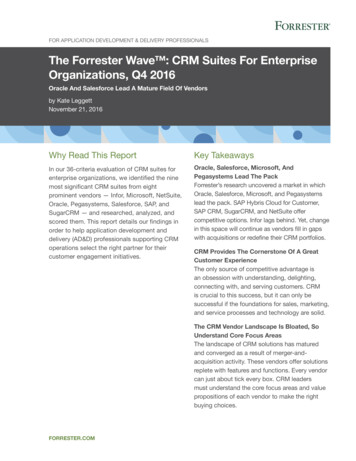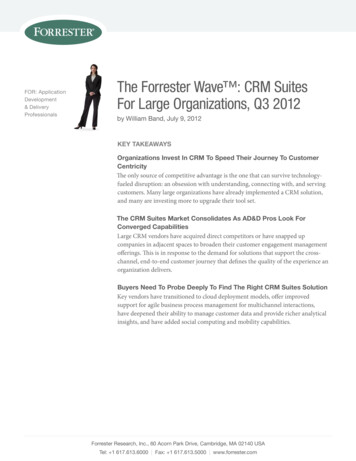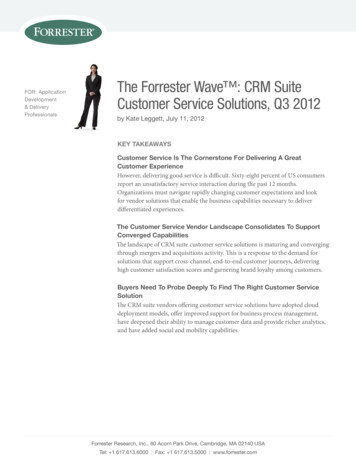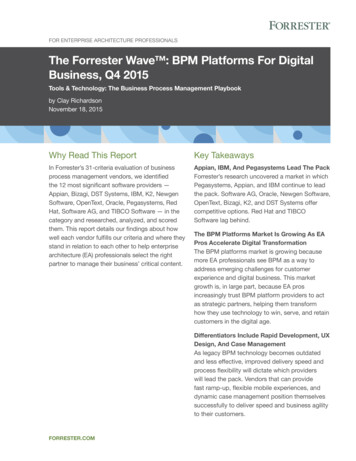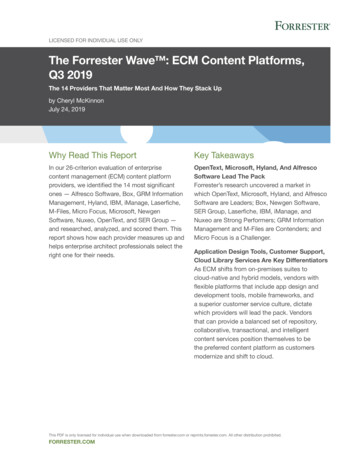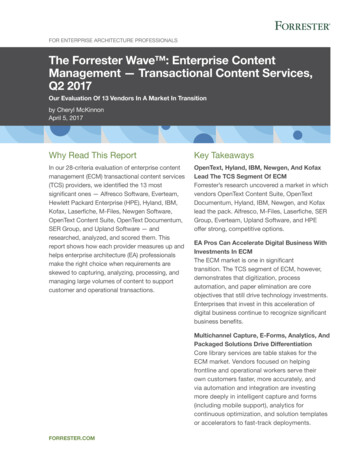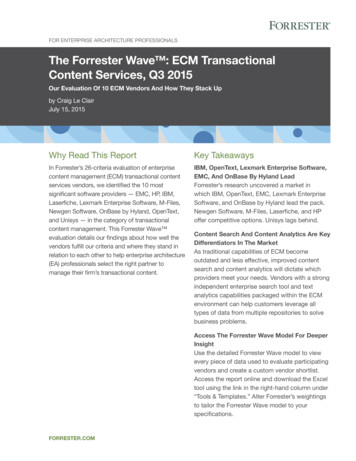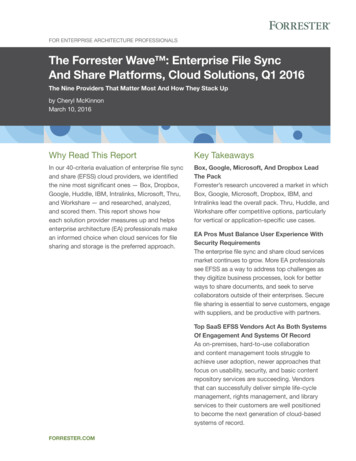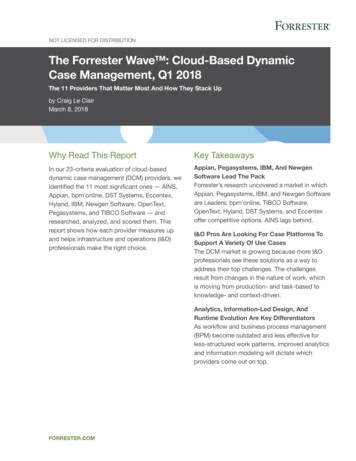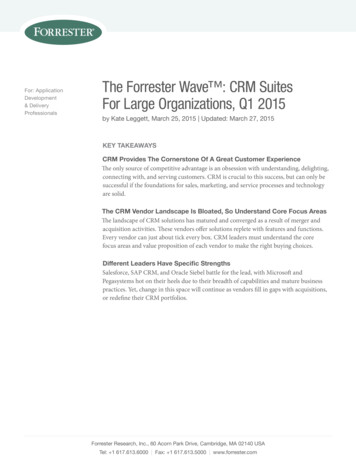
Transcription
For: ApplicationDevelopment& DeliveryProfessionalsThe Forrester Wave : CRM SuitesFor Large Organizations, Q1 2015by Kate Leggett, March 25, 2015 Updated: March 27, 2015Key TakeawaysCRM Provides The Cornerstone Of A Great Customer ExperienceThe only source of competitive advantage is an obsession with understanding, delighting,connecting with, and serving customers. CRM is crucial to this success, but can only besuccessful if the foundations for sales, marketing, and service processes and technologyare solid.The CRM Vendor Landscape Is Bloated, So Understand Core Focus AreasThe landscape of CRM solutions has matured and converged as a result of merger andacquisition activities. These vendors offer solutions replete with features and functions.Every vendor can just about tick every box. CRM leaders must understand the corefocus areas and value proposition of each vendor to make the right buying choices.Different Leaders Have Specific StrengthsSalesforce, SAP CRM, and Oracle Siebel battle for the lead, with Microsoft andPegasystems hot on their heels due to their breadth of capabilities and mature businesspractices. Yet, change in this space will continue as vendors fill in gaps with acquisitions,or redefine their CRM portfolios.Forrester Research, Inc., 60 Acorn Park Drive, Cambridge, MA 02140 USATel: 1 617.613.6000 Fax: 1 617.613.5000 www.forrester.com
For Application Development & Delivery ProfessionalsMarch 25, 2015Updated: March 27, 2015The Forrester Wave : CRM Suites For LargeOrganizations, Q1 2015Salesforce, SAP, Oracle, And Microsoft Lead A Mature Field OfVendorsby Kate Leggettwith Stephen Powers, Fraser Tibbetts, and Arelai EphraimWhy Read This ReportIn this Forrester Wave evaluation of customer relationship management (CRM) suites for enterpriseorganizations, we identified the nine most significant CRM suites solutions — Infor CRM (formerlyknown as SalesLogix), Microsoft Dynamics CRM, NetSuite, Oracle Siebel CRM, Pegasystems, Salesforce,SAP CRM, SAP Cloud for Customer, and SugarCRM — and researched, analyzed, and scored them. Thisreport details our findings in order to help application development and delivery (AD&D) professionalssupporting CRM operations select the right partner for their customer engagement initiatives.Table Of ContentsNotes & Resources2 Modern CRM Supports Customers In TheirEnd-To-End JourneysForrester conducted vendor surveyevaluations in November 2014 and evaluated10 CRM solutions worthy of consideration bylarge organizations. We also surveyed vendorcustomers.3 The CRM Market Is On The Cusp OfSignificant Change4 More Is Not Better In The CRM Market —Sometimes It Is Worse8 CRM Evaluation Overview10 The Results: Salesforce, SAP, Oracle, AndMicrosoft Dominate12 Vendor Profiles18 Supplemental MaterialRelated Research DocumentsNavigate The Future Of CRM In 2015January 22, 2015Transform Customer Processes And SystemsTo Improve ExperiencesJanuary 13, 2014TechRadar For AD&D Pros: The ExtendedCRM Technology Ecosystem, Q1 2013January 29, 2013 2015, Forrester Research, Inc. All rights reserved. Unauthorized reproduction is strictly prohibited. Information is based on best availableresources. Opinions reflect judgment at the time and are subject to change. Forrester , Technographics , Forrester Wave, RoleView, TechRadar,and Total Economic Impact are trademarks of Forrester Research, Inc. All other trademarks are the property of their respective companies. Topurchase reprints of this document, please email clientsupport@forrester.com. For additional information, go to www.forrester.com.
For Application Development & Delivery Professionals2The Forrester Wave : CRM Suites For Large Organizations, Q1 2015Modern CRM Supports Customers In Their End-To-End JourneysForrester defines CRM as:The business processes and supporting technologies that support the key activities of targeting,acquiring, retaining, understanding, and collaborating with customers.Companies leverage CRM to provide operational efficiencies for sales, marketing, and customerservice organizations when interacting with customers — an “inside-out” approach. Users leverageCRM to aggregate and analyze opportunity and customer data, as well as automate workflows tooptimize customer engagement processes. To quantify CRM’s return on investment, companiesexamine operational metrics such as reduced marketing costs, increased revenues from salespeople,decreased sale cycle times, better pipeline visibility, decreased service resolution times, and more.As a result, interest in deploying CRM technologies continues. Our data shows that almosttwo-thirds of technology decision-makers at enterprise organizations indicate that they haveimplemented a subset of CRM capabilities.1 Specifically, 41% have already implemented acustomer service and support (CSS) solution; 34% have implemented a sales force automation(SFA) application; and 26% have implemented marketing automation — and many are planningto upgrade their tool sets. An additional 30%, 31%, and 28% have plans to adopt a CSS, SFA, andmarketing automation solution within the next few years, respectively (see Figure 1).Today, forward-thinking companies build on these internal operational efficiencies and extend thepower of CRM to better support customers through their end-to-end engagement journey. Thisgarners their satisfaction and long-term loyalty. Good customer experiences correlate to customerloyalty, and loyal customers are more willing to consider another purchase from a company, are lesslikely to switch business to a competitor, and are more likely to recommend. Our models estimatethat the revenue impact from a 10-percentage-point improvement in a company’s performance, asmeasured by Forrester’s Customer Experience Index (CX Index) score, could exceed 1 billion.2 2015, Forrester Research, Inc. Reproduction ProhibitedMarch 25, 2015 Updated: March 27, 2015
For Application Development & Delivery Professionals3The Forrester Wave : CRM Suites For Large Organizations, Q1 2015Figure 1 Many Decision-Makers’ Enterprises Have Already Implemented A CRM Solution“What are your firm’s plans to adopt the following packaged/vendor-built(not custom) business applications?”(Enterprise [1,000 or more employees])AlreadyimplementedPlanning toimplementMarketing automationCustomer service and support (CSS)Sales force automation (SFA)Interested butno plans26%Not interested28%41%34%18%Don’t know21% 7%30% 14% 11%31% 12%19%4%5%Base: 1,087 global technology decision-makers (1,000 employees)Source: Forrester’s Business Technographics Global Software Survey, 2014119104Source: Forrester Research, Inc. Unauthorized reproduction or distribution prohibited.The CRM Market Is On The Cusp Of Significant ChangeThe CRM vendor space is mature. Yet there have been many changes in the last five years and morechange is likely to continue. Two driving factors will accelerate these changes.Big Fish Eat Little Fish, And Each Bite Broadens The Reach Of The Big FishThe CRM market has consolidated in the last five years. For example, Oracle, focused on providingconsistent end-to-end customer experiences across touchpoints, has made numerous acquisitionsto round out its customer experience portfolio.3 SAP, like Oracle, provides consistent end-to-endcustomer experiences via its breadth of products and has made a few key acquisitions to round outits capabilities.4 Salesforce made a series of moves to round out the service cloud.5 It has used thissame tactic to broaden its CRM footprint with the notable acquisition of ExactTarget for businessto-company (B2C) marketing automation (2013).Other acquisitions of note include: Microsoft’s acquisition of Netbreeze (2013) for social listeningand Parature (2014), which helps Microsoft Dynamics add knowledge management and chatcapabilities; Pegasystems acquisition of Chordiant Software (2010) for process-centric CRM andAntenna Software (2013) for mobile development; and Infor’s acquisition of SalesLogix (2014) fromSwiftpage, which had acquired it from the Sage Group (2013). 2015, Forrester Research, Inc. Reproduction ProhibitedMarch 25, 2015 Updated: March 27, 2015
For Application Development & Delivery Professionals4The Forrester Wave : CRM Suites For Large Organizations, Q1 2015Vendors Offering Point Solutions Go After The Enterprise PlayersThese large CRM vendors increasingly offer broader and deeper capabilities which bloat their footprintand increase their complexity with features that many users can’t leverage. At the same time, new pointsolution vendors are popping up at an unprecedented rate and are delivering modern interfaces andmobile-first strategies that address specific business problems such as sales performance management,lead to revenue management, and digital customer experience. You just have to look at the entry list forthe yearly CRM Idol competition to get a feel for the range of these offerings.6 Of course, these vendorshave a long way to go to prove their capabilities in an enterprise setting.Compounding this is the reality that most companies make technology purchasing decisions inorganizational silos — a trend accentuated by the rise of software-as-a-service (SaaS) CRM. Thistrend may herald the end of the bloated CRM category. Forrester predicts that CRM will fragmentto better support end-to-end business processes.We will see a deeper alignment between sales and marketing CRM to support lead-to-revenuemanagement processes. Customer service CRM solutions will converge with workforceoptimization, queuing, and routing technologies to better support the end customer and moreeffectively manage agent workloads.7 Keep an eye on this space, and choose vendors carefully as theCRM landscape is ripe for change.More Is Not Better In The CRM Market — Sometimes It Is WorseEach of the leading vendors in this mature market offers a checklist of features and functions.Remember that more is not better; many times more is just more. In fact, when you don’t needor can’t use extra features, more is sometimes worse. CRM buyers must understand the marketsegmentation in order focus in on the right category of vendor that is the right size for their needs.Ask What Size Organization Each Vendor TargetsEven with market consolidation, CRM solutions fall into four primary groups to choose from,although the distinctions between these categories have become less pronounced over the past threeyears (see Figure 2): CRM suites for large organizations. CRM vendors focused on large organizations —organizations with 1,000 or more employees — typically offer a full range of functionalitysupporting multiple languages and geographies. Many vendors offer deeply vertical solutions,and have pre- and post-sale company resources dedicated to their support. Vendors in thiscategory also target midsize organizations, offering prepackaged versions of their solutions withmore affordable price tags. The leading vendors in this category are highlighted in this report. 2015, Forrester Research, Inc. Reproduction ProhibitedMarch 25, 2015 Updated: March 27, 2015
For Application Development & Delivery Professionals5The Forrester Wave : CRM Suites For Large Organizations, Q1 2015 CRM suites for midsize organizations. Vendors primarily target these solutions atorganizations or divisions of larger enterprises with 250 to 999 employees. They often havemore-limited capabilities in specific areas and are simpler to use than solutions built for theenterprise market. Some vendors in this category have upgraded their solutions to be moresuitable to enterprise-class buyers and are gaining acceptance in that segment as well. Wehighlight the leading vendors in this category in the upcoming Forrester Wave evaluation ofCRM suites for midsize organizations.8 CRM solutions for small organizations. These vendors primarily target organizations with upto 250 employees. Functionality is limited compared with what full CRM suite solutions offerand typically focuses on basic contact management (including social channel interactions) andemail marketing capabilities for individuals or small teams. CRM specialty tools. This category comprises vendors that offer solutions with narrowfunctional breadth but deep specialty capabilities — such as marketing automation andcustomer service — for both large and midmarket organizations. This category also includesCRM vendors that specialize in specific industries such as financial services, life sciences,telecommunications, and the not-for-profit sector. 2015, Forrester Research, Inc. Reproduction ProhibitedMarch 25, 2015 Updated: March 27, 2015
For Application Development & Delivery Professionals6The Forrester Wave : CRM Suites For Large Organizations, Q1 2015Figure 2 CRM Solutions Fall Into Four Distinct CategoriesExamples of CRM suites for large organizationsExamples of CRM specialty solutionsCRM suites primarily designed forfirms with 1,000 employees or more Infor CRM Microsoft Dynamics CRM* NetSuite Oracle Siebel CRM Pegasystems CRM Salesforce* SAP Cloud for Customer SAP CRM SugarCRM*Customer service solutions: Astute Solutions Customer Service Software eGain Software KANA Enterprise Oracle Service Cloud Parature Customer Service Software Spaces by Moxie ZendeskExamples of CRM suites for midsize organizationsCustomer marketing automation solutions: Adobe Campaign IBM Campaign Infor Epiphany Marketing SAS Customer Intelligence Platform Teradata Integrated Marketing CloudCRM suites primarily designed for firms with250 to 999 employees Aptean Pivotal CRM bpm’onlineExamples of industry specialist solutions: Infor CRM Amdocs CES Customer Relationship Maximizer CRMManagement (telecommunications) Microsoft Dynamics CRM* Blackbaud (not-for-profits) NetSuite Cegedim Group (life sciences) Sage CRM NexJ Systems (financial services) SAP Cloud for Customer StayinFront (life sciences) Salesforce* Update Software AG (life sciences) SugarCRM* Veeva Systems (life sciences)Examples of CRM solutions for small organizations Capsule CRM GoldMine CRM Infusionsoft Nimble Swiftpage Act Zoho*These vendors have a significant base of both enterprise and midmarket customers.119104Source: Forrester Research, Inc. Unauthorized reproduction or distribution prohibited. 2015, Forrester Research, Inc. Reproduction ProhibitedMarch 25, 2015 Updated: March 27, 2015
For Application Development & Delivery Professionals7The Forrester Wave : CRM Suites For Large Organizations, Q1 2015Factor Size, Complexity, And Business Model Into Your CRM DecisionThe CRM needs for a business-to-business (B2B) company are not the same as the needs for a B2Ccompany. Likewise, the needs of a sales organization are not the same as that of a customer serviceorganization. Carefully evaluate the CRM Forrester Wave criteria to pick a solution that is the rightsize for your needs. In many cases, too many features can be overkill for enterprise organizationwith lightweight needs. Consider a number of capabilities to right-size for strategy (see Figure 3):Figure 3 Right-Size Your CRM For Your NeedsCategory Consider your requirements to supportSales force automation Complex sales processes, including quote to cash, renewals Complex team and territory management processes Predictive analytics to increase sales productivity Mobile requirements for traveling employeesMarketing automation Marketing resource management needs Complex, multistage and recurring campaigns Complex lead management workflows Online and offline communication channels Offer management, including analytics to optimize offersCustomer service CTI integration Omnichannel communications Agent guidance for scripted processes Knowledge management for agents and customers Feedback from customersField service Core field service needs (dispatch, scheduling, service order management) Spare parts management Warranty management Mobile support for field employeeseCommerce Transactional features (shopping cart, search, promotions, personalization) Order management Returns/exchangesBusiness intelligence Reports and dashboards Advanced analytics capabilities, including predictive modeling, simulations,and statistical analysisUsability and user Consistent, role- based, intuitive user interfaces across touchpoints (web, mobile,experience app, tablet) Task-based user experiences Easily customizable UIs119104Source: Forrester Research, Inc. Unauthorized reproduction or distribution prohibited. 2015, Forrester Research, Inc. Reproduction ProhibitedMarch 25, 2015 Updated: March 27, 2015
For Application Development & Delivery Professionals8The Forrester Wave : CRM Suites For Large Organizations, Q1 2015CRM Evaluation OverviewForrester evaluated each vendor against 95-criteria, categorized into the following three areas: Current offering. Each vendor’s position on the vertical axis of the Forrester Wave graphicindicates the strength of its current product offering. We looked at the strength of each vendor’sproducts across a spectrum of CRM capabilities, including sales force automation, marketingautomation, customer service, field service, eCommerce, business intelligence, customer datamanagement, technology, and architecture. Strategy. A vendor’s position on the horizontal axis indicates our assessment of its strategy. Weassessed the strength of each vendor’s product strategy and product vision. We assessed theapplication ownership experience, cost, and corporate strategy of each vendor. Market presence. The size of each vendor’s bubble on the chart indicates its market presence.We gauged the size of each vendor’s customer base and evaluated the depth of human andfinancial resources available to enhance its products and serve its customers.Vendor Selection CriteriaWe included nine solutions in our assessment of CRM suites for large organizations, including: InforCRM, Microsoft Dynamic CRM, NetSuite, Oracle (Oracle Siebel CRM), Pegasystems, Salesforce, SAP(SAP Cloud for Customer and SAP CRM), and SugarCRM. We did not assess solutions focused ona single industry, nor on those that specialize in a subset of CRM functionalities, such as standalonesales force automation vendors, customer service vendors, or marketing automation vendors.Each vendor included in this Forrester Wave evaluation (see Figure 4): Sells a multifunctional CRM applications suite. Each vendor included in this Forrester Waveevaluation has functionality in a minimum of three of the following CRM subdisciplines andtools: marketing, sales force automation, customer service, field service, eCommerce, customeranalytics, and customer data management. Products promoted primarily as best-of-breedsolutions for a single functional area were not included. Offers a CRM application with common services. Included vendor solutions must havecommon services for data management, authentication, administration, configuration, identity,and permissions management. Suites of vendor products that comprise a CRM bundle and donot share common services are not included in this evaluation. Has a solution suitable for large organizations with complex requirements. Vendors weincluded focus on, and have references from, large organizations with complex requirements. Theserequirements include the ability to scale on a global basis, manage end-to-end business processes,integrate into complex legacy environments, and manage large volumes of customer-related data. 2015, Forrester Research, Inc. Reproduction ProhibitedMarch 25, 2015 Updated: March 27, 2015
For Application Development & Delivery Professionals9The Forrester Wave : CRM Suites For Large Organizations, Q1 2015 Provides a solution targeted to multiple industries. Evaluated vendors target buyers across adiverse range of industries and business models. Has a product now in general release and in use by customers. The solutions we includedhave a specific release that was generall
The Forrester Wave : CRM Suites For Large Organizations, Q1 2015 y Kate Leggett, March 25, 2015 Updated: March 2, 2015 For: application Development Delivery Professionals Key TaKeaways CRM Provides The Cornerstone Of a Great Customer experience The only source of competitive
